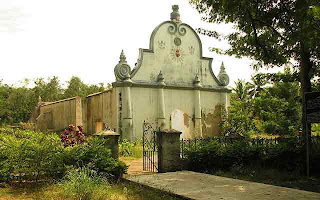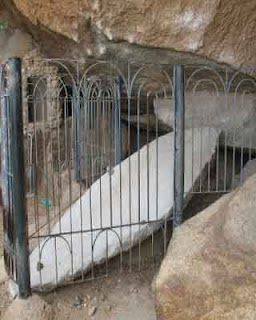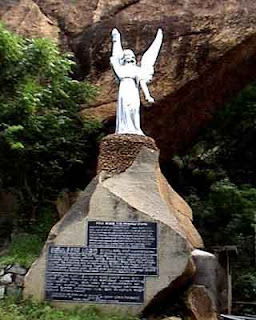
Neelakanta Pillai, baptized as Devasahayam Pillai, the Servant of God, was an 18th century convert from Hinduism to Christianity in the Southernmost part of India was born on 23rd April 1712 at Nattalam, erstwhile in Travancore Kingdom, at present Kanyakumari District in Tamilnadu, India, was belonged to the royal Nair-caste family. His father Vasudevan Namboodiri hailed from Kayamkulam in Kerala State and was working as a swamiyar (Priest) at Sree Adi Kesava Perumal Temple in Thiruvattar in Kanyakumari district. His mother Devaki Amma hailed from Thiruvattar in Kanyakumari district. In the Nair matriarchal traditions of the day, Neelakanda Pillai was raised-up by his maternal uncle and was inculcated with Hindu beliefs and traditions early on.
You Can Read More Missionaries' Biographies
Here!!!
Early Life of Neelakanta Pillai
Name: Neelakanta Pillai
Born: April 23, 1712, Nattalam
Father: Vasudevan Namboodiri
Mother: Devaki Amma
Baptized: May 14, 1745, Vadakkankulam
Mission Work: Travancore, (Kanyakumari)
Died: January 14, 1752, Aralvoimozhy
Honored in: Roman Catholic Church
Beatified: Efforts being taken
His early life, he learnt Sanskrit and had traditional training in martial arts. Besides Tamil and Malayalam, the languages of people, he trained himself in Archery, Varmasastra and the use of weapons of war. Neelakandan's family had much influence in the royal palace of Maharaja Marthanda Varma, King of Travancore Regime and Neelakanta Pillai went into the service of the royal palace as a young man. His capabilities and enthusiasm did not go overlooked in the palace, as he was soon put in charge of state affairs as an official under Ramayyan Dalawa, the Dewan of Travancore.
 |
| Neelakanda Pillai's old Home Situated Here |
Eustachius Benedictus De Lannoy
 |
| Devasahayam Shrine, Natalam |
In performing his duties as a palace official, Neelakanda Pillai came in contact with a Catholic Officer, Captain Eustachius Benedictus De Lannoy, a Dutch Naval Commander, who was arrested by King of Travancore Marthanda Varma after the battle between Travancore forces and Dutch East India Company, which headed by De Lannoy at Colachel in 1741. The Dutch forces were defeated at war at the Port of Colachel. Many Dutchmen, including De Lannoy and his assistant Donadi, were taken as prisoners, while the rest either ran away or were killed. Later Delannoy was appointment as a Travancore Army Commander by the King of Travancore.Many of the forts like the Vattakottai Fort facing the sea near Kanyakumari, the Savakkotta and the Marunnu Kotta both being hill-forts near Padmanabhapuram were built under De Lannoy’s supervision. Udayagiri Fort, very close to the fortified capital of Padmanabhapuram was a military training centre and barracks
Conversion to Christianity
Eustachius Benedictus De Lannoy and the Dutchmen were later pardoned by the King, on condition that they serve in the Travancore army. De Lannoy later earned the trust of the king and went on to become the commander of the Travancore armed forces, winning many battles and annexing various adjacent territories to Travancore. Neelakanda Pillai and De Lannoy became well acquainted. De Lannoy's Christian faith interested Neelakandan and De Lannoy enlightened him on the faith leading to his conversion to Christianity in 1745.
 |
| St.Xavier's Church Kottar |
Baptism
On Neelakandan's acceptance of the Christian faith, Rev.Fr.Giovanni Baptista Buttari, a Jesuit Missionary at Vadakankulam village in Tirunelveli District of Tamilnadu, examined his past life in order to instruct him and to test the maturity of his decision and the depth of his conviction in the Catholic faith. This instruction continued for nine months. Finally, moved by the persistence of Neelakanda Pillai, he baptized him at the church of Vadakkankulam on 14 May 1745. At baptism, the Servant of God was given the name "Devasahayam" which is a Tamil rendering of the biblical name Lazar, which means "God has helped".
 |
| De lannoy Tomb at Udayagiri Fort |
Exhorting others for Baptism
Devasahayam himself started exhorting others to receive Baptism and even converted some to Christian faith one of them, Bargavi Ammal of Mekkod, a neighbouring village, changed her name Gnanapu. Later he married her. Fearing reprisal in Travancore against her religious conversion, she chose to be a migrated-resident of this village. Some of his immediate family members also received baptism later after being converted to Christianity.
Accusation and False Charges
 |
| Bell Rock Aralvoimozhi |
In his personal life, he mingled with people of all statuses and castes. Because of his newly found faith he disregarded caste distinction, threw away the symbols of his "high" caste, ate and lived with people of "low" birth and came to the palace-office as a "polluted" person. Noticing the marked changes in Devasahayam because of his Christian life, Brahmin Chief Swamiyar (Priest), the members of the royal household and the Nair community brought accusation and false charges on Devasahayam to the Dewan, Ramayyan Dalawa. Devasahayam was divested of his portfolio in the administration and arrested him on 23 February 1749 and put him in a very narrow prison. Soon condemned to death by the King, he was tortured in several ways. He was paraded to many towns and villages, both hands bound behind his back, seated on a buffalo facing backward, garlanded with Erukku flowers as a symbol of shame.
Other traditions and beliefs, Devasahayam was marched all the way to Aralvaimozhy by soldiers, over the period of a few days. As was customary in those days for very cruel criminals, his body was painted with red and black spots, and he was intentionally marched through populated areas, sitting backward on top of a water buffalo throughout South Travancore from Padmanabhapuram palace. On the way en-route, he was daily beaten with eighty stripes, pepper rubbed in his wounds and nostrils, exposed to the sun, and given only stagnant water to drink.
 |
| Holy Place, Puliyoorkurichi |
Devasahayam at Aralvaimozhy
 |
| Devasahayam Pillai Mount |
He was brought through a small place called Puliurkurichy where overcome by thirst he planted his elbow on the rock, which gave forth water which he could drink. This rock continues to give water even today and People visit this fountain in large numbers. Through the soldiers brought him to Peruvilai and detained him there for about seven months, tied in a neem tree. It is there that Devasahayam became friendly with the soldiers and was helped to meet the Catholic priests. He received Holy Communion from these priests. In 1752, the original order of the King and his Dewan was to deport him from Travancore into the Pandya Country at Aralvaimozhy. He was let off in the forested hills near Aralvaimozhy. There, he is believed to have begun deep meditations and the people from the adjacent villages began visiting the holy man. At this time, high caste Hindus plotted to do away with Devasahayam.
Death
Some people believe that the soldiers went up the forested hills and tried to shoot Devasahayam, but were unable to fire; after which he took the gun in his hands, blessed it and gave it back to the soldiers to shoot him to death, if they wished to. The soldiers took the gun back and fired at him five times. At Kattadimali in Kanyakumari District that Devasahayam Pillai died on 14th January 1752. His body was thrown in between rocks and left there to be eaten by wild animals. His mortal remains were discovered by the Christians and buried in front of the main altar in the most important church of St.Francis Xavier, which is the present Cathedral of the Diocese of Kottar.
 |
| Devasahayam body founded there |
Canonization efforts
According to the report submitted by the then Bishop of Cochin in 1756 AD, the Christian Martyrdom of Devasahayam Pillai was promptly intimated to Vatican. Prominent witnesses to his saintliness and Martyrdom include Paremmakkal Thoma Kathanar. In 1780, Kariattil Ouseph Malpan took an effort and submitted a petition to the Vatican for canonization of Devasahayam Pillai. In 1984, a group of laymen once again took the initiative to seek the beatification of Devasahayam. This is unusual for a layman, but he is regarded as one who was totally devoted to Christ.
At the beginning of the 21st century, many Christian devotees started offering prayers at his tomb. In 2004, after a series of initiatives and much deliberation, the Catholic Bishops' Conference of India (CBCI), Tamil Nadu Council recommended his beatification to the Vatican, following scrutiny of available historical evidence, in consultation with others. Bishop Chrysostom said that the CBCI did not intend any controversy whatsoever in moving this forward.
Places of Interest about Martyr
 |
| His final prayer |
Devasahyam Pillai was buried in the Cathedral of St.Francis Xavier at Kottar in Nagercoil, Kanyakumari District, Tamil Nadu, India. His clothes and other belongings are kept in a church in the small town of Vadakkankulam in Tirunelveli District of Tamil Nadu State, India. They are exposed at the church on 15 August every year, the feast of the Assumption of Mary. His wife was buried in the cemetery there. Puliyoorkurichi, location of the water fountain believed to have quenched Devasahayam's thirst, is on the Nagercoil – Trivandrum highway. Aralvaimozhy, eight kms from Nagercoil where he was killed, is between Nagercoil-Tirunelveli highway. At that spot on the hillock (called Kaattadimalai), devotees believe that rocks fell and were broken at that moment. One rock at the place makes bell-like sounds when knocked with a stone.
 Neelakanta Pillai, baptized as Devasahayam Pillai, the Servant of God, was an 18th century convert from Hinduism to Christianity in the Southernmost part of India was born on 23rd April 1712 at Nattalam, erstwhile in Travancore Kingdom, at present Kanyakumari District in Tamilnadu, India, was belonged to the royal Nair-caste family. His father Vasudevan Namboodiri hailed from Kayamkulam in Kerala State and was working as a swamiyar (Priest) at Sree Adi Kesava Perumal Temple in Thiruvattar in Kanyakumari district. His mother Devaki Amma hailed from Thiruvattar in Kanyakumari district. In the Nair matriarchal traditions of the day, Neelakanda Pillai was raised-up by his maternal uncle and was inculcated with Hindu beliefs and traditions early on.
Neelakanta Pillai, baptized as Devasahayam Pillai, the Servant of God, was an 18th century convert from Hinduism to Christianity in the Southernmost part of India was born on 23rd April 1712 at Nattalam, erstwhile in Travancore Kingdom, at present Kanyakumari District in Tamilnadu, India, was belonged to the royal Nair-caste family. His father Vasudevan Namboodiri hailed from Kayamkulam in Kerala State and was working as a swamiyar (Priest) at Sree Adi Kesava Perumal Temple in Thiruvattar in Kanyakumari district. His mother Devaki Amma hailed from Thiruvattar in Kanyakumari district. In the Nair matriarchal traditions of the day, Neelakanda Pillai was raised-up by his maternal uncle and was inculcated with Hindu beliefs and traditions early on.











Comments
Post a Comment